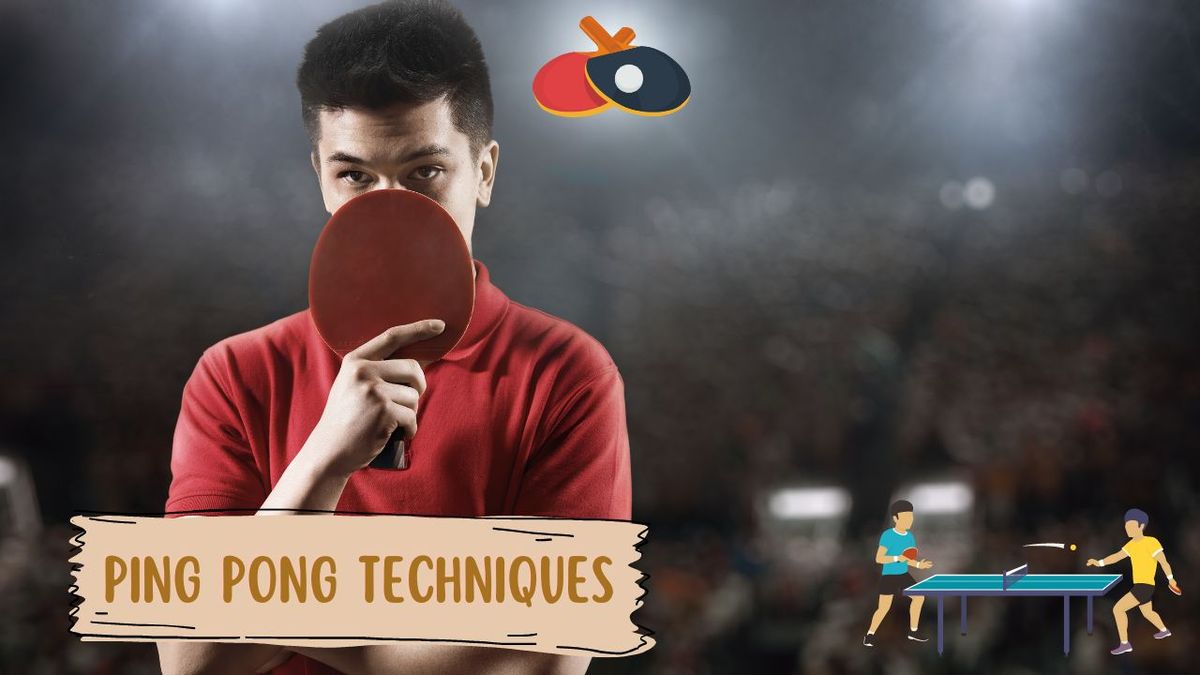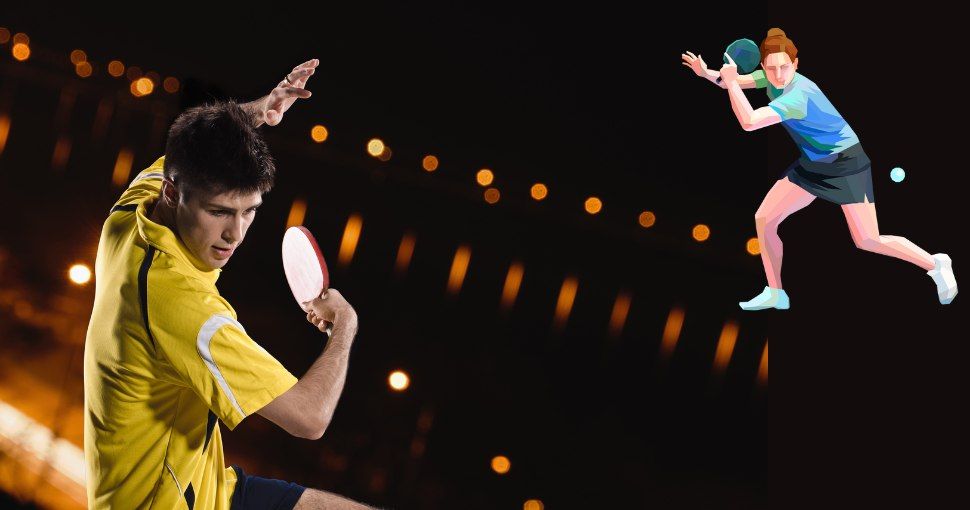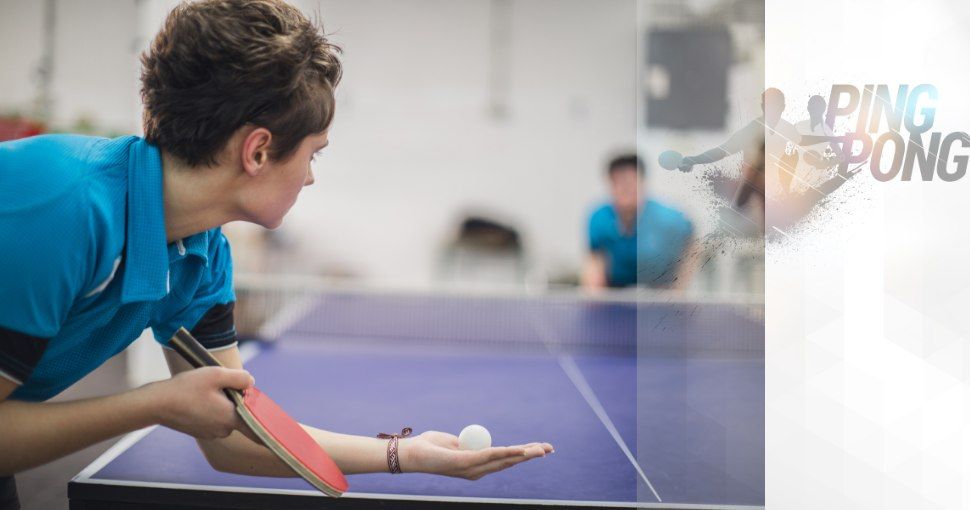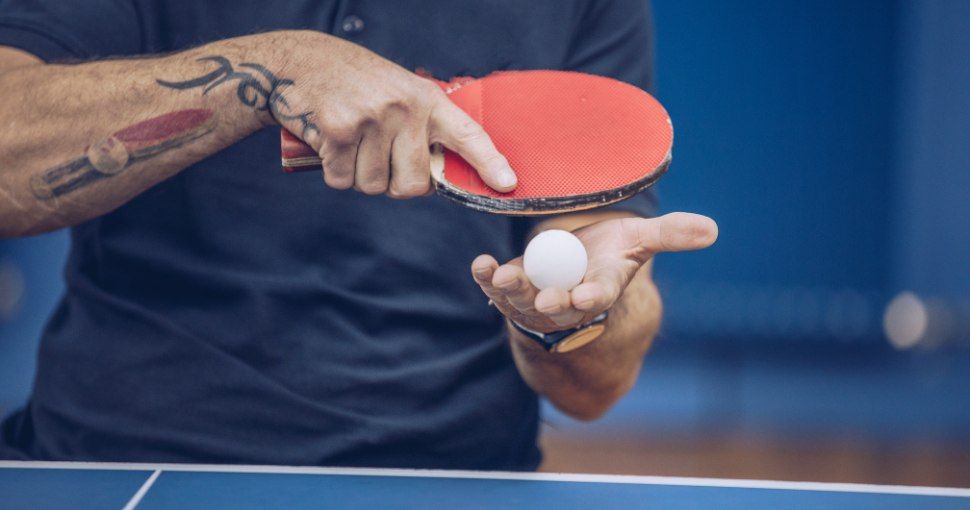Ping Pong Techniques
Dive into the world of ping pong with this captivating article that unveils unconventional techniques for mastering the sport. From mysterious spins to tactical wizardry, discover how to take your ping pong skills to the next level.

Are you ready to take your ping-pong skills to the next level? Or maybe you're gearing up for an office ping pong tournament, determined to show your colleagues who the real champ is. Whatever your ping-pong ambitions, we've got you covered.
In this article, we're diving deep into the world of Ping Pong techniques, revealing the secrets to that perfect spin, lightning-fast return, and the following victory dance.
Forehand & Backhand Drive
Start with your feet shoulder-width apart and knees slightly bent. Hold the paddle with a shakehand or pen-hold grip, depending on your preference. Stand close to the table, and position yourself so that your non-dominant side (left for right-handed players, right for left-handed) faces the net.
For a backhand drive, your swing should primarily come from your wrist and forearm. Keep your elbow close to your body and maintain a relaxed wrist. Make contact with the ball in front of your body, ideally when it's at the peak of its bounce.
After striking the ball, follow through with your paddle. Your follow-through should be in the direction you want the ball to go. The backhand drive is excellent for placing the ball precisely where you want it. Focus on accuracy and control.
You can apply topspin (for offensive shots) or underspin (for defensive shots) to the backhand drive by adjusting the angle of your paddle and the brushing motion on the ball. Like any ping pong technique, mastering the backhand drive requires practice. Work on your footwork, timing, and consistency to improve your backhand game.
The backhand drive is a versatile shot that can be used for offensive attacks, counterattacks, and defensive plays, making it a fundamental technique in table tennis.
Backhand Push
Start with your feet shoulder-width apart and knees slightly bent. Hold the paddle with a shakehand or pen-hold grip, depending on your preference. Stand close to the table, and position yourself so that your non-dominant side (left for right-handed players, right for left-handed) faces the net.

The backhand push is a controlled and defensive shot. Your swing should come primarily from your wrist and forearm. Keep your elbow close to your body and maintain a relaxed wrist.
Make contact with the ball in front of your body, ideally when it's at the peak of its bounce. To create a backspin on the ball, angle your paddle slightly downward at the moment of contact. This imparts a backspin and keeps the ball low.
After striking the ball, follow through with your paddle, but the follow-through should be short and controlled, unlike the longer follow-through of an attacking shot. The backhand push is primarily a defensive shot used to control the pace of the game and set up offensive opportunities. Focus on keeping the ball on the table and placing it where your opponent has difficulty attacking.
You can vary the placement of your backhand pushes to different areas of the table, making it challenging for your opponent to predict your shots. Consistent practice is essential to perfect the backhand push. Work on your timing, placement, and ability to read your opponent's shots.
Adaptability: The backhand push is a valuable tool for handling opponents' spin shots, and serves, and for initiating rallies. It's an essential component of an all-around ping-pong game.
Block
The Block in table tennis is a defensive stroke executed close to the table, primarily used to counter fast-paced topspin shots from the opponent. To perform the backhand or front-hand block, assume a relaxed and balanced stance with your feet shoulder-width apart.
As your opponent's ball approaches, pivot your body slightly to the side, aligning your non-playing shoulder towards the net. Keep your racket hand relaxed and slightly in front of your body, angling the racket slightly downward. As the ball comes in contact with the racket, use a short, controlled motion to deflect it back over the net.
Focus on timing and precision, allowing the ball's pace and spin to be absorbed by your racket's angle. Maintain a relaxed grip and utilize your wrist to fine-tune the angle of your racket. The block is a crucial technique for maintaining control during rallies and transitioning between defensive and offensive playstyles. Regular practice and refining your timing will enhance the effectiveness of this defensive stroke.
Develop Sidespin Serves
Start sidespin on their serves to improve your skill. Medium to advanced skill-level players use sidespin frequently. Sidespin is almost always combined with either topspin or backspin.

Sidespin is extremely rare in table tennis. Particularly useful is a sidespin/backspin serve that is low to the net and bounces twice on the other side of the table. This type of serve will seriously limit your opponent’s serve return options.
Keep Returns Low Over The Net
The lower over the net you place your shots, the less angle your opponent can use and the harder it is for them to hit it with power. The one exception to this is if you use lobs, you will want to place the ball very high over the net. This can make it difficult for your opponent to pick up when it is as close to the end of the table as possible.
Backhand Loop
Playing a successful backhand or forehand loop in table tennis involves generating controlled topspin shots that can outmaneuver opponents. To execute a backhand loop, stand with a slightly open stance, using your non-dominant foot forward, while keeping your racket below the ball's contact point.
As the ball approaches, pivot your hips and shoulders, brushing the ball from low to high with a slightly closed racket angle to impart topspin. For a forehand loop, position your dominant foot forward, maintaining a square stance. As the ball arrives, rotate your hips and shoulders, brushing the ball's lower half with an open racket face.
Both loops demand coordinated body movement, proper timing, and precise racket angles to ensure effective shots with enhanced spin and accuracy. Regular practice and mastering these techniques can significantly elevate your table tennis game.
Backhand Punch
Mastering the art of the backhand or forehand punch in table tennis involves precise technique and timing. For the backhand punch, position yourself with your feet shoulder-width apart and knees slightly bent.
As the ball approaches your backhand side, pivot your body and rotate your hips while keeping your non-dominant hand on the racket for balance. With a firm grip, use a swift and compact motion to punch the ball, aiming for a quick, flat trajectory over the net.
On the other hand, executing a forehand punch requires shifting your weight to your front foot, creating a solid foundation. As the ball comes to your forehand side, rotate your hips and shoulders in unison while maintaining eye contact with the ball.
A controlled wrist snap during contact imparts topspin, resulting in a powerful shot. In both cases, practice and fine-tuning of these techniques are essential to deliver accurate and forceful punches in your table tennis matches.
Counter Loop
Playing a counter loop in table tennis involves a strategic blend of anticipation, timing, and technique. This advanced technique is executed when a player responds to an opponent's topspin shot with a topspin shot of their own, aiming to maintain control and shift the momentum of the rally.

To successfully execute a counter loop, one must read the spin and trajectory of the incoming ball, position themselves optimally to generate power and employ a fluid wrist movement to impart topspin. The key lies in using the opponent's spin against them, redirecting the energy with precise racket angles and a well-timed stroke.
Mastering the counter loop demands practice, exceptional hand-eye coordination, and an understanding of varying spins to consistently dictate the pace of the game while keeping the adversary on the defensive.
Identify What Spin Is On The Ball
Observe your opponent’s racket when it makes contact with the ball. If your opponent’s racket is moving from:
- Low to high ― the spin is topspin
- High to low ― the spin is backspin
- Their left to right ― the spin is right sidespin
- Their right to left ― the spin is left sidespin
Ping Pong Techniques
FAQs
Q: What are the 7 skills in table tennis?
Answer: Table tennis, also known as ping pong, is a fast-paced and highly skilled sport that requires a combination of physical abilities and technical skills. While there are many skills and techniques involved, here are seven fundamental skills in table tennis.
- Table Tennis Grip: A proper grip is crucial for control and power in your shots. The two most common grips are the shakehand grip and the pen-hold grip.
- Footwork: Good footwork is essential for positioning yourself to reach the ball quickly and efficiently. You need to move around the table effectively to maintain your balance and reach the ball in time.
- Serve and Receive: Serving and receiving are key aspects of the game. Being able to deliver a variety of serves with spin and precision while reading and countering your opponent's serves is crucial.
- Forehand Stroke: The forehand is the most commonly used stroke in table tennis. Developing a powerful and accurate forehand shot is essential for offensive play.
- Backhand Stroke: While the forehand gets more attention, a strong backhand is equally important. It allows you to cover more of the table and defend effectively.
- Spin and Control: Understanding and using spin is vital. This involves not only generating spin on your shots but also reading and adapting to the spin on your opponent's shots.
- Tactics and Strategy: Table tennis is not just about hitting the ball; it's also about outsmarting your opponent. Developing strategies, knowing when to attack or defend, and adjusting your game based on your opponent's strengths and weaknesses are critical skills.
Q: What are the 3 rules of ping pong?
Answer: Ping pong, also known as table tennis, has several rules that govern the game. Here are three fundamental rules:
- Service Rules:
- The ball must be placed in the server's open palm.
- The server must toss the ball vertically at least 6 inches (about 15 centimeters) into the air before hitting it.
- The ball must be struck from behind the end line (baseline) of the table.
- The serve must first bounce on the server's side of the table and then clear the net to land on the receiver's side of the table diagonally opposite.
- Scoring Rules:
- A standard game is played to 11 points.
- A player must win by a margin of at least two points.
- After each point, the server alternates between players, and the receiver alternates between points until a game is won.
- Let Rule:
- If the ball hits the net during a serve (a "let"), it is replayed without counting as a point, and the server serves again.
- During a rally (not a serve), if the ball hits the net and lands on the opponent's side, the point continues. However, if it hits the net and doesn't go over, it's considered a point for the opponent.
Q: How can I improve my ping-pong skills?
Answer: Improving your ping pong skills requires practice, dedication, and a systematic approach to training. Here are some steps to help you enhance your table tennis abilities:
- Fundamental Techniques
- Start by mastering the basic strokes: forehand, backhand, and serve. Focus on proper technique, grip, and body positioning.
- Footwork
- Develop good footwork to position yourself quickly and efficiently to reach the ball. Practice moving forward, backward, and sideways. Work on consistency by rallying with a partner or a wall. Try to hit the ball consistently on the table without making mistakes.
- Spin and Control
- Learn to apply spin to the ball and how to handle different types of spin. Practice spin serves and receive techniques.
- Match Play
- Play as many matches as you can. This will help you apply your skills under pressure and improve your decision-making in real-game situations.
- Watch and Learn
- Watch professional table tennis matches to observe their techniques, strategies, and footwork. You can find many matches online.
- Training Drills
- Incorporate training drills into your practice routine. Drills can focus on specific aspects of your game, such as consistency, footwork, or returning serves. Consider working with a table tennis coach. They can provide personalized feedback, correct your technique, and help you develop a training plan.
- Physical Conditioning
- Enhance your physical fitness. Cardiovascular endurance, agility, and core strength are all essential for table tennis. Develop mental toughness by practicing concentration, focus, and staying calm under pressure. Visualization and mindfulness techniques can help.
- Play Against Better Players
- Challenge yourself by playing against opponents who are more skilled than you. This will push you to improve faster. Record your matches and practice sessions. Analyze your performance to identify weaknesses and areas for improvement.
- Equipment
- Invest in a good-quality table tennis racket and suitable equipment. The right equipment can make a significant difference in your game.
- Stay Patient and Persistent
- Improvement takes time. Be patient with yourself and stay dedicated to your practice regimen.
- Participate in Tournaments:
- If you're serious about improving, consider participating in local table tennis tournaments. Competing against a variety of players will help you gain experience and confidence.
Q: What is the most important skill in ping pong?
Answer: Determining the "most important" skill in ping pong can be somewhat subjective and can depend on your playing style and goals. However, many would argue that consistency is one of the most crucial skills in table tennis. Here's why:
Consistency
- Consistency refers to the ability to consistently place the ball on the table during rallies, reducing unforced errors.
- A consistent player can control the placement, speed, and spin of their shots with precision, making it challenging for the opponent to attack or counter.
- Consistency allows you to maintain control of the point and puts pressure on your opponent to make mistakes.
- In many cases, a player with strong consistency can outlast their opponent, forcing them into making errors or creating opportunities for offensive shots.
Q: What are the 5 technical skills in table tennis?
Answer: In table tennis, there are several technical skills that players need to develop to excel in the sport. Here are five key technical skills:
- Stroke Techniques
- Forehand Stroke: Mastering the forehand is crucial, as it's one of the most frequently used shots in table tennis. Focus on proper grip, wrist action, and body rotation to generate power and spin.
- Backhand Stroke: Similar to the forehand, the backhand stroke is important for covering different angles on the table. Develop both a backhand drive and a backhand loop for versatility.
- Serve Techniques: Serving is a technical skill that includes a variety of spins, placements, and deception. Learn to perform different types of serves, such as topspin, backspin, sidespin, and no-spin serves.
- Receiving Techniques
- Receiving Serves: Developing the ability to read your opponent's serve and respond effectively is crucial. This includes controlling the return, dealing with spin, and attacking when possible.
- Footwork
- Efficient footwork is fundamental to reaching the ball quickly and positioning yourself correctly. Work on both lateral and diagonal movements, as well as transitioning from offensive to defensive positions.
- Spin Control
- Understanding and controlling spin is a technical skill that involves recognizing the spin on the incoming ball and adjusting your stroke accordingly. This includes topspin, backspin, sidespin, and combinations of these spins.
- Blocking and Defensive Skills
- While the offense is essential, having strong blocking and defensive skills is equally important. Learn to block incoming attacks with precision and control. Develop defensive chops and lobs for more extended rallies.
advanced
Key Takeaways!
Mastering ping pong techniques is essential for success in the sport. Developing precise stroke techniques, honing spin control, perfecting footwork, and refining defensive skills are all critical components of a well-rounded table tennis game. Continuous practice and dedication to these techniques will undoubtedly lead to improvement and success on the ping pong table.
Articles Worth Reading!
- Unleashing the Ping Pong Game: A Journey into the Heart of Table Tennis
- Ping Pong Balls You Need to Up Your Table Tennis Game!
- Reasons Owning a Ping Pong Table Will Be Your Best Purchase
- Discover the World of Portable Ping Pong On-the-Go Excitement!
- Unleash Your Inner Ping Pong Champion: Exploring the Game's Thrills & Tricks
Sponsored By:

